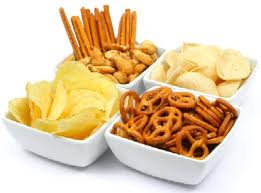 Cooked starches such as potato chips, corn flakes, crackers, bread and pasta have decay-causing power equal to sugars.
Cooked starches such as potato chips, corn flakes, crackers, bread and pasta have decay-causing power equal to sugars.
How sticky a food feels when you chew it does not relate to how long that food remains in the mouth. A caramel feels sticky, but it clears the mouth in minutes. A potato chip doesn’t feel sticky, but it can remain in the mouth for hours. It takes a long time for starches to break down into sugars that then dissolve and clear the mouth. Therefore, starchy foods can be especially harmful to the teeth.
Low sugar foods such as milk, fruits, even vegetables can start the tooth decay process. Cavity-causing bacteria in the mouth can’t tell the difference between a small or large amount of sugar or starch; it takes only a small amount to get them started. More sugar in food doesn’t mean more cavities. It’s frequent snacking that keeps the decay process going.
 Some foods have anti-cavity power! Certain cheeses such as Monterey Jack, Swiss and aged Cheddar can heal small breaks in the tooth enamel where a cavity is about to form. Cheese also stimulates the flow of saliva and eliminates the production of harmful acids that cause tooth decay. Cheese is a great snack for dental health!
Some foods have anti-cavity power! Certain cheeses such as Monterey Jack, Swiss and aged Cheddar can heal small breaks in the tooth enamel where a cavity is about to form. Cheese also stimulates the flow of saliva and eliminates the production of harmful acids that cause tooth decay. Cheese is a great snack for dental health!
Chocolate, licorice, peanuts, and cashews are also friendly to teeth. Licorice(black, not red) reacts much as a cheese does. It can help heal early breaks in the tooth enamel. Peanuts, chocolate and other cocoa products (including low fat chocolate milk) can block the buildup of plaque on the teeth.
Since almost all foods have cavity-causing potential, you need to focus more on the frequency of snacking than on the type of snack to protect your child’s dental health. Provide snacks based on nutritional value and your child’s preferences, and limit the number of snacks to three or four per day. Your child’s teeth should be brushed with fluoride toothpaste twice daily.
Courtesy : Google images
